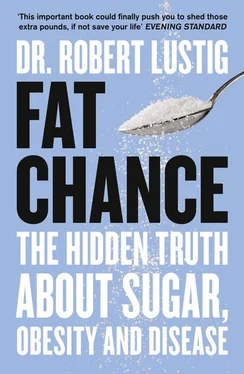It is from this perception of choice that we derive our current societal mantras around obesity: gluttony and sloth, two of the original “seven deadly sins.” I should note here that people exhibiting the other five deadly sins (greed, pride, lust, envy, and wrath) have gotten a pass in the press and in society as a whole. They are frequently extolled in the media – just watch the reality shows The Apprentice (envy, greed, pride, wrath—“You’re Fired!”), Millionaire Matchmaker (lust, greed, pride), or Jersey Shore (all known sins and then some).
We’ve found absolution for nearly every vice and sin we can commit, except for these two. They continue to defy our society’s ability to forgive. This despite the fact that 55 percent of Americans are either overweight or obese. Thin people are now in the minority, yet our culture continues to punish the majority. The average woman in the United States wears a size 14, yet many stores do not carry anything above a size 10. Although many women’s clothing stores now have “vanity sizes” (what was a size 10 in 1950 is now labeled a size 6), a large percentage of the population still can’t find anything on the rack. Approximately ten years ago in San Francisco, a billboard advertising the local 24-Hour Fitness health club depicted an extraterrestrial with the tag line “When they come, they’ll eat the fat ones first.”
Our society continues to glorify thinness even though it appears to be less achievable every year. Those of us who are overweight or obese are immediately assumed to be gluttons and/or sloths. The obese are passed over for employment because it’s assumed they’ll be as lazy on the job as they are in caring for their bodies. They are among the last groups about which you can still make pejorative comments in public. From this condemnation, it’s a quick jump to the determination that obese people became so due to a behavioral defect. This formulation serves many purposes. It certainly justifies society’s desire to place blame.
Even the obese have bought into the thesis of personal responsibility (see chapter 20). They would prefer to be portrayed as “perpetrator” rather than “victim.” If you’re a perpetrator, you maintain control and make your own choices, which is more hopeful than the alternative. If, instead, you’re a victim, you have no power, obesity is your fate, and there is no hope. You’re doomed, which is far more depressing. Finally, “personal responsibility” serves as the cornerstone of both the government’s and the insurance companies’ restriction of obesity care delivery.
Seat 2: The Health Insurance Industry
Much of the public views doctors as moneymaking mountebanks who care less for their patients than for their wallets. Well, we lose money on every patient we see. While our hospital’s general pediatric health insurance reimbursement averages 37.5 cents on the dollar (a pittance), our pediatric obesity clinic collects only 29.0 cents per dollar billed. The reason for this? The health insurance industry refuses to pay for obesity services, saying, “Obesity is a behavior, a flaw in your character, a psychological aberration. And we don’t pay for behavior.” This is the reason that, despite having enough business many times over, childhood obesity clinics and treatment programs are closing across the country. The insurance industry has decided that obesity is a lifestyle choice; therefore, it won’t pay. And when insurance companies do pay, they pay the absolute minimum.
The insurance industry hates this obesity epidemic almost as much as we doctors do. They are hunkering down for a long siege. Why do they continue to deny reimbursement for obesity services? Because if they paid for all the services required by today’s pandemic, it would break their piggybank. Instead, they keep plugging holes in the dike by ascribing blame to the individual. They know that if they ever admit that obesity is the fault of no one person, the waters will engulf them all.
Seat 3: The Medical Profession
Twenty years ago, obesity was a social issue, not a medical one. At the beginning of my career, a colleague in pediatric endocrinology (the study of hormones in children) would send a form letter to the parents of children referred for obesity that read, “Dear parent, thank you for your interest in our pediatric endocrinology division. Your child has been referred for obesity. Obesity is a problem of nutrition and activity, not one of endocrinology. We suggest that you seek general advice from your child’s pediatrician.” And despite the undeniable onslaught of patients referred, many of my colleagues still feel this way.
As the problems have soared and the research dollars have poured in, the American Diabetes Association (ADA), the American Heart Association (AHA), and countless others professional organizations have devoted a substantial portion of their agendas to the obesity pandemic. The standard mantra espoused by the medical establishment is, “Lifestyle causes obesity, and obesity causes metabolic syndrome.” We doctors recognize our role in mitigating the negative effects of obesity. But, again, for most physicians, the behaviors come first. The fault still lies with the patient.
Seat 4: The Obesity Profiteers
They say, “You’re weak. You’ve failed. Let us help you.” They profess to have the answer for your obesity problem and are peddling one solution or another. They are the obesity profiteers, and they represent large and vast industries, most of which are ostensibly trying to “do the right thing,” while making a fortune in the process. We have the otherwise reputable peer-group weight-loss programs such as Weight Watchers and Jenny Craig, which strongly recommend the option of buying their trademarked cuisine (often loaded with sodium) to bolster profits. There are the diet supplement people such as Nutri-System, who demand that you purchase their food if you want to see results. Gym programs such as Curves and 24-Hour Fitness charge initiation and renewal fees for membership. Then there are the companies that make home exercise equipment. Their late-night infomercials invariably show a buff guy stretching a rubber band with the implicit message, “You can look like this if you stretch a rubber band.” And then we have the “obesity authors” (gee, I’m one now!). Some are M.D.s, some Ph.D.s, some journalists, some pop culture phenomena, and some charlatans (none of which is mutually exclusive). All profess to have the answer to your obesity problem, peddling one diet or another. A few of these authors have developed corporations that want to sell you their food line, such as Atkins or the Zone. And each provides just enough science and nuggets of truth to hook the public.
Some weight-loss doctors and clinics peddle prescription appetite suppressants or other weight-loss remedies – all of which are paid for out of pocket. Some of these doctors are reputable and brilliant academics at medical universities who are trying to save people’s lives while studying the physiology of obesity. Some are surgeons who perform liposuction for cosmetic purposes and bariatric surgery for metabolic and cardiac rescue. But some of them are “cut-and-run” surgeons operating out of small airplanes and flying around to little towns to perform quickie lap-band surgeries or gastric bypasses. They take their victims’ money, have no quality control, never see the patient in follow-up, and sometimes leave medical catastrophes in their wake.
While the insurance companies refuse to shell out funds for this problem, the research money is pouring in. The pharmaceutical industry has spent a lot of money to come up with the “obesity blockbuster,” that magic bullet that will work long-term and for everyone. But that’s a pipe dream because, first, obesity isn’t one disease, it’s many; second, our bodies have many redundant pathways to maintain our critical energy balance, so one drug can’t possibly be effective for everyone; and third, there’s no one drug that will treat metabolic syndrome (see chapter 19).
Читать дальше












